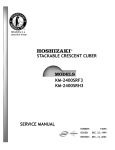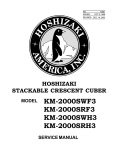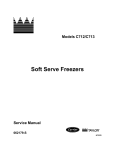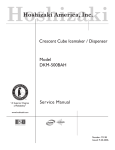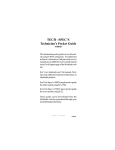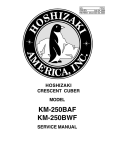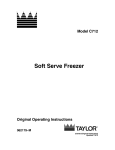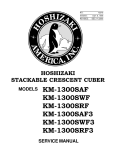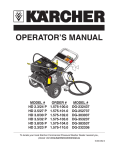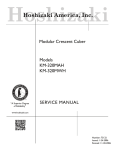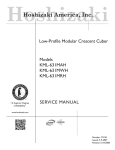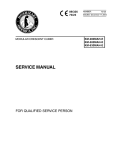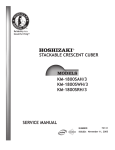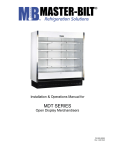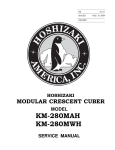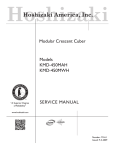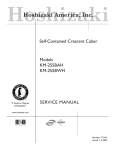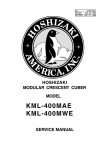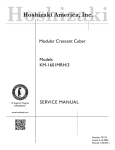Download Service Manual - Whaley Food Service
Transcript
NO.:
ISSUED:
REVISED:
73079
DEC. 8, 1998
DEC. 16, 2003
HOSHIZAKI
STACKABLE CRESCENT CUBER
MODEL
KM-1600SWF
KM-1600SRF
KM-1600SWF3
KM-1600SRF3
SERVICE MANUAL
IMPORTANT
Only qualified service technicians should attempt to service or maintain this icemaker.
No service or maintenance should be undertaken until the technician has thoroughly
read this Service Manual.
HOSHIZAKI provides this manual primarily to assist qualified service technicians in the
service and maintenance of the icemaker.
Should the reader have any questions or concerns which have not been satisfactorily
addressed, please call or write to the HOSHIZAKI Technical Support Department for
assistance.
HOSHIZAKI AMERICA, INC.
618 Highway 74 South
Peachtree City, GA 30269
Attn: HOSHIZAKI Technical Support Department
Phone: 1-800-233-1940 Technical Service
(770) 487-2331
Fax:
(770) 487-3360
NOTE: To expedite assistance, all correspondence/communication MUST include the following
information:
•
Model Number
•
Serial Number
•
Complete and detailed explanation of the problem
2
Please review this manual. It should be read carefully before the icemaker is serviced or
maintenance operations are performed. Only qualified service technicians should service and
maintain the icemaker. This manual should be made available to the technician prior to
service or maintenance.
CONTENTS
PAGE
I. SPECIFICATIONS ............................................................................................................. 5
1. KM-1600SWF (Water-cooled) ...................................................................................... 5
2. KM-1600SRF (Remote air-cooled) ............................................................................... 6
3. KM-1600SWF3 (Water-cooled) .................................................................................... 7
4. KM-1600SRF3 (Remote air-cooled) ............................................................................. 8
5. CONDENSING UNIT, URC-20F .................................................................................. 9
II. GENERAL INFORMATION ............................................................................................. 11
1. CONSTRUCTION ...................................................................................................... 11
[a] KM-1600SWF, KM-1600SWF3 ............................................................................ 11
[b] KM-1600SRF, KM-1600SRF3 .............................................................................. 12
2. CONTROLLER BOARD ............................................................................................. 13
[a] SOLID-STATE CONTROL ................................................................................... 13
[b] CONTROLLER BOARD ....................................................................................... 13
[c] SEQUENCE ......................................................................................................... 18
[d] CONTROLS AND ADJUSTMENTS .................................................................... 21
[e] CHECKING CONTROLLER BOARD .................................................................. 24
III. TECHNICAL INFORMATION ........................................................................................ 26
1. WATER CIRCUIT AND REFRIGERANT CIRCUIT ................................................... 26
[a] KM-1600SWF, KM-1600SWF3 ............................................................................ 26
[b] KM-1600SRF, KM-1600SRF3 .............................................................................. 27
2. WIRING DIAGRAMS .................................................................................................. 28
[a] KM-1600SWF, KM-1600SRF ............................................................................... 28
[b] KM-1600SWF3, KM-1600SRF3 ........................................................................... 29
3. TIMING CHART ......................................................................................................... 30
4. PERFORMANCE DATA ............................................................................................ 32
[a] KM-1600SWF ....................................................................................................... 32
[b] KM-1600SRF ....................................................................................................... 33
[c] KM-1600SWF3 ..................................................................................................... 34
[d] KM-1600SRF3 ..................................................................................................... 35
IV. SERVICE DIAGNOSIS ................................................................................................. 36
1. NO ICE PRODUCTION .............................................................................................. 36
2. EVAPORATOR IS FROZEN UP ................................................................................ 39
3. LOW ICE PRODUCTION ........................................................................................... 39
4. ABNORMAL ICE ........................................................................................................ 40
5. OTHERS .................................................................................................................... 40
3
V. REMOVAL AND REPLACEMENT OF COMPONENTS............................................... 41
1. SERVICE FOR REFRIGERANT LINES ................................................................... 41
[a] REFRIGERANT RECOVERY ............................................................................. 41
[b] EVACUATION AND RECHARGE ...................................................................... 41
2. BRAZING .................................................................................................................. 42
3. REMOVAL AND REPLACEMENT OF COMPRESSOR........................................... 43
4. REMOVAL AND REPLACEMENT OF DRIER ......................................................... 44
5. REMOVAL AND REPLACEMENT OF EXPANSION VALVE ................................... 45
6. REMOVAL AND REPLACEMENT OF HOT GAS VALVE, ...........................................
LINE VALVE AND GAS VALVE ................................................................................ 46
7. REMOVAL AND REPLACEMENT OF EVAPORATOR ........................................... 47
8. REMOVAL AND REPLACEMENT OF WATER-REGULATING VALVE ......................
- WATER COOLED MODEL ONLY .......................................................................... 48
9. ADJUSTMENT OF WATER-REGULATING VALVE ....................................................
- WATER COOLED MODEL ONLY .......................................................................... 49
10. REMOVAL AND REPLACEMENT OF CONDENSING PRESSURE ...........................
REGULATOR (C.P.R.) - REMOTE AIR-COOLED MODEL ONLY ............................ 50
11. REMOVAL AND REPLACEMENT OF THERMISTOR ............................................. 51
12. REMOVAL AND REPLACEMENT OF FAN MOTOR ................................................ 52
13. REMOVAL AND REPLACEMENT OF WATER VALVE ........................................... 52
14. REMOVAL AND REPLACEMENT OF PUMP MOTOR ............................................. 53
15. REMOVAL AND REPLACEMENT OF SPRAY TUBES ........................................... 54
VI. MAINTENANCE AND CLEANING INSTRUCTIONS .................................................. 55
1. PREPARING THE ICEMAKER FOR LONG STORAGE........................................... 55
2. CLEANING PROCEDURE ....................................................................................... 57
[a] CLEANING PROCEDURE ................................................................................. 58
[b] SANITIZING PROCEDURE ................................................................................ 59
3. MAINTENANCE ........................................................................................................ 60
4
I. SPECIFICATIONS
1. KM-1600SWF
5
2. KM-1600SRF
AC SUPPLY VOLTAGE
AMPERAGE
MINIMUM CIRCUIT AMPACITY
MAXIMUM FUSE SIZE
APPROXIMATE ICE PRODUCTION
PER 24 HR.
lbs./day (kg/day)
Reference without *marks
SHAPE OF ICE
ICE PRODUCTION PER CYCLE
APPROXIMATE STORAGE CAPACITY
ELECTRIC & WATER CONSUMPTION
ELECTRIC W (kWH/100lbs.)
POTABLE WATER
gal./24HR (gal./100 lbs.)
EXTERIOR DIMENSIONS (WxDxH)
EXTERIOR FINISH
WEIGHT
CONNECTIONS - ELECTRIC
- WATER SUPPLY
- DRAIN
CUBE CONTROL SYSTEM
HARVESTING CONTROL SYSTEM
ICE MAKING WATER CONTROL
COOLING WATER CONTROL
BIN CONTROL SYSTEM
COMPRESSOR
CONDENSER
EVAPORATOR
REFRIGERANT CONTROL
REFRIGERANT CHARGE
DESIGN PRESSURE
P.C. BOARD CIRCUIT PROTECTION
COMPRESSOR PROTECTION
REFRIGERANT CIRCUIT PROTECTION
LOW WATER PROTECTION
ACCESSORIES - SUPPLIED
- REQUIRED
OPERATING CONDITIONS
208-230/60/1 (3 wire with neutral for 115V)
21A (5 Min. Freeze AT104°F / WT 80°F)
30A
30A
Ambient
WATER TEMP. (°F)
Temp.(°F)
50
70
70
*1430 (649)
1415 (642)
80
1419 (644)
1396 (633)
90
1415 (642) *1380 (626)
100
1383 (628)
1359 (616)
Crescent Cube
30.9 lbs. (14 kg) 1440 pcs.
N/A
70/50°F
90/70°F
2815 (4.67)
2965 (5.80)
841 (58.8)
504 (36.5)
90
1343 (609)
1295 (588)
1290 (585)
1207 (547)
48" x 27-3/8" x 27-3/8" (1219 x 695 x 695 mm)
Stainless Steel, Galvanized Steel (Rear)
Net 285 lbs. ( 129 kg ), Shipping 360 lbs. (163 kg )
Permanent Connection
Inlet 1/2" FPT
Outlet 3/4" FPT
3/8" ID Pipe
Float Switch
Hot Gas and Water. Thermistor and Timer
Timer Controlled. Overflow Pipe
N/A
Thermostat
Hermetic, Model CS20K6E-PFV-279
Air-cooled remote, Condenser Unit URC-20F recommended
Vertical type. Stainless Steel and Copper
Thermostatic Expansion Valve
Condensing Pressure Regulator on URC-20F
R-404A, 14 lbs. 12 oz. (6700 g)
(Ice maker 7 lbs. 1 oz. Cond. unit 7 lbs. 11 oz.)
High 467 PSIG, Low 230 PSIG
High Voltage Cut-out (Internal)
Auto-reset Overload Protector (Internal)
Auto-reset High Pressure Control Switch
Float Switch
N/A
Ice Storage Bin, Remote Condenser Unit
VOLTAGE RANGE
187 - 264 V
AMBIENT TEMP.
45 - 100°F
WATER SUPPLY TEMP.
45 - 90°F
WATER SUPPLY PRESSURE
10 - 113 PSIG
We reserve the right to make changes in specifications and design without prior notice.
6
3. KM-1600SWF3
AC SUPPLY VOLTAGE
AMPERAGE
MINIMUM CIRCUIT AMPACITY
MAXIMUM FUSE SIZE
APPROXIMATE ICE PRODUCTION
PER 24 HR.
lbs./day ( kg/day )
Reference without *marks
SHAPE OF ICE
ICE PRODUCTION PER CYCLE
APPROXIMATE STORAGE CAPACITY
ELECTRIC & WATER CONSUMPTION
ELECTRIC W (kWH/100 lbs.)
POTABLE WATER
WATER COOLED CONDENSER
gal./24HR (gal./100 lbs.)
EXTERIOR DIMENSIONS (WxDxH)
EXTERIOR FINISH
WEIGHT
CONNECTIONS - ELECTRIC
- WATER SUPPLY
- DRAIN
CUBE CONTROL SYSTEM
HARVESTING CONTROL SYSTEM
ICE MAKING WATER CONTROL
COOLING WATER CONTROL
BIN CONTROL SYSTEM
COMPRESSOR
CONDENSER
EVAPORATOR
REFRIGERANT CONTROL
REFRIGERANT CHARGE
DESIGN PRESSURE
P.C. BOARD CIRCUIT PROTECTION
COMPRESSOR PROTECTION
REFRIGERANT CIRCUIT PROTECTION
LOW WATER PROTECTION
ACCESSORIES -SUPPLIED
-REQUIRED
OPERATING CONDITIONS
208-230/60/3
9.5 A ( 5 Min. Freeze AT 104°F / WT 80°F)
20 A
20 A
Ambient
WATER TEMP. (°F)
Temp.(°F)
50
70
90
70
*1500 (680)
1495 (678)
1451 (658)
80
1496 (679)
1489 (675)
1423 (646)
90
1495 (678)
*1484 (673)
1426 (647)
100
1473 (668)
1470 (667)
1373 (623)
Crescent Cube
30.9 lbs. ( 14 kg ) 1440 pcs.
N/A
90/70°F
70/50°F
2597 (4.2)
2563 (4.1)
463 (31.2)
887 (59.1)
1914 (129.0)
1005 (67.0)
48" x 27-3/8" x 27 3/8" (1219 x 695 x 695 mm)
Stainless Steel, Galvanized Steel (Rear)
Net 310 lbs. ( 141 kg ), Shipping 360 lbs. ( 163 kg )
Permanent - Connection
Inlet
1/2" FPT
Cond. Inlet
1/2" FPT
Outlet
3/4" FPT
Cond. Outlet 1/2" FPT
3/8" OD Pipe
Float Switch
Hot Gas and Water, Thermistor and Timer
Timer Controlled. Overflow Pipe
Water Regulator
Thermostat
Hermetic, Model CS20K6E-PFV
Water-cooled, Tube in tube type
Vertical type, Stainless Steel and Copper
Thermostatic Expansion Valve
R-404A,
3 lb. 1 oz. ( 1400 g )
High 427 PSIG, Low 230 PSIG
High Voltage Cut-out ( Internal )
Auto-reset Overload Protector ( Internal )
Auto-reset High Pressure Control Switch
Float Switch
N/A
Ice Storage Bin
VOLTAGE RANGE
187 - 253 V
AMBIENT TEMP.
45 -100° F
WATER SUPPLY TEMP.
45 - 90° F
WATER SUPPLY PRESSURE
10 - 113 PSIG
We reserve the right to make changes in specifications and design without prior notice.
7
4. KM-1600SRF3
AC SUPPLY VOLTAGE
AMPERAGE
MINIMUM CIRCUIT AMPACITY
MAXIMUM FUSE SIZE
APPROXIMATE ICE PRODUCTION
PER 24 HR.
lbs./day (kg/day)
Reference without *marks
SHAPE OF ICE
ICE PRODUCTION PER CYCLE
APPROXIMATE STORAGE CAPACITY
ELECTRIC & WATER CONSUMPTION
ELECTRIC W (kWH/100lbs.)
POTABLE WATER
gal./24HR (gal./100 lbs.)
EXTERIOR DIMENSIONS (WxDxH)
EXTERIOR FINISH
WEIGHT
CONNECTIONS - ELECTRIC
- WATER SUPPLY
- DRAIN
CUBE CONTROL SYSTEM
HARVESTING CONTROL SYSTEM
ICE MAKING WATER CONTROL
COOLING WATER CONTROL
BIN CONTROL SYSTEM
COMPRESSOR
CONDENSER
EVAPORATOR
REFRIGERANT CONTROL
REFRIGERANT CHARGE
DESIGN PRESSURE
P.C. BOARD CIRCUIT PROTECTION
COMPRESSOR PROTECTION
REFRIGERANT CIRCUIT PROTECTION
LOW WATER PROTECTION
ACCESSORIES - SUPPLIED
- REQUIRED
OPERATING CONDITIONS
208-230/60/3
11A (5 Min. Freeze AT104°F / WT 80°F)
20A
20A
Ambient
WATER TEMP. (°F)
Temp.(°F)
50
70
70
*1461 (663)
1426 (647)
80
1434 (651)
1380 (626)
90
1426 (647) *1341 (608)
100
1409 (639)
1325 (601)
Crescent Cube
30.9 lbs. (14 kg) 1440 pcs.
N/A
90/70°F
70/50°F
2900 (5.10)
2775 (4.57)
452 (29.7)
773 (52.9)
90
1365 (619)
1311 (595)
1274 (578)
1213 (550)
48" x 27-3/8" x 27-3/8" (1219 x 695 x 695 mm)
Stainless Steel, Galvanized Steel (Rear)
Net 285 lbs. ( 129 kg ), Shipping 360 lbs. (163 kg )
Permanent Connection
Inlet 1/2" FPT
Outlet 3/4" FPT
3/8" ID Pipe
Float Switch
Hot Gas and Water. Thermistor and Timer
Timer Controlled. Overflow Pipe
N/A
Thermostat
Hermetic, Model CS20K6E-TF5-279
Air-cooled remote, Condenser Unit URC-20F recommended
Vertical type. Stainless Steel and Copper
Thermostatic Expansion Valve
Condensing Pressure Regulator on URC-20F
R-404A, 14 lbs. 12 oz. (6700 g)
(Ice maker 7 lbs. 1 oz. Cond. unit 7 lbs. 11 oz.)
High 467 PSIG, Low 230 PSIG
High Voltage Cut-out (Internal)
Auto-reset Overload Protector (Internal)
Auto-reset High Pressure Control Switch
Float Switch
N/A
Ice Storage Bin, Remote Condenser Unit
VOLTAGE RANGE
187 - 264 V
AMBIENT TEMP.
45 - 100°F
WATER SUPPLY TEMP.
45 - 90°F
WATER SUPPLY PRESSURE
10 - 113 PSIG
* We reserve the right to make changes in specifications and design without prior notice.
8
5. CONDENSING UNIT
URC-20F
9
SPECIFICATIONS
MODEL: URC-20F
EXTERIOR
Galvanized Steel
DIMENSIONS (W x D x H)
46 - 3/8" x 15 - 11/16" x 25 - 15/16"
(1178 x 398 x 659 mm)
REFRIGERANT CHARGE
R404A 7 lbs.11 oz. (3500 g)
URC-20F
Net 104 lbs. (47 kg)
Shipping 150 lbs. (52 kg)
WEIGHT
One Shot Couplings (Aeroquip)
Permanent Connection
CONNECTIONS
REFRIGERANT
ELECTRICAL
Air-cooled
CONDENSER
Condensing Pressure Regulator
HEAD PRESSURE CONTROL
Min. -20°F - Max. +122°F
(-29°C to +50°C)
Outdoor use
AMBIENT CONDITION
10
II. GENERAL INFORMATION
1. CONSTRUCTION
[a] KM-1600SWF, KM-1600SWF3
Evaporator
Spray Tube
Water Valve
Water Supply Inlet
Expansion Valve
Hot Gas Valve
Junction Box
Water-cooled
Condenser
Check Valve
Control Box
Water Regulator
Water Pump
Float Switch
Drier
Cleaning Valve
Line Valve
Compressor
Transformer Box
(KM-1600SWF3)
Capacitor Box
(KM-1600SWF)
Control Switch
Bin Control Thermostat
11
[b] KM-1600SRF, KM-1600SRF3
Evaporator
Spray Tube
Water Valve
Expansion Valve
Water Supply Inlet
Hot Gas Valve
Junction Box
Check Valve
Control Box
Receiver Tank
Water Pump
Float Switch
Drier
Cleaning Valve
Line Valve
Compressor
Transformer Box
(KM-1600SRF3)
Capacitor Box
(KM-1600SRF)
Control Switch
Bin Control Thermostat
12
2. CONTROLLER BOARD
[a] SOLID-STATE CONTROL
1) A HOSHIZAKI exclusive solid-state control is employed in KM-2000SWF3 and
KM-2000MRF3 Stackable Crescent Cubers.
2) A Printed Circuit Board (hereafter called “Controller Board”) includes a stable and high
quality control system.
3) All models are pretested and factory-adjusted.
[b] CONTROLLER BOARD
CAUTION
1. Fragile, handle very carefully.
2. A controller board contains integrated circuits, which are susceptible to
failure due to static discharge. It is especially important to touch the metal
part of the unit when handling or replacing the board.
3. Do not touch the electronic devices on the board or the back of the board to
prevent damage to the board.
4. Do not change wiring and connections. Do not misconnect K3, K4 and K5,
because the same connector is used for the Thermistor and Float Switch.
K4 is not connected.
5. Always replace the whole board assembly when it goes bad.
6. Do not short out power supply to test for voltage.
PART NUMBER
2A0836-01
or 2A1410-01
TYPE
HOSIZAKI-001 (Control Products - 8 Pin)
HOS-001A (Control Products - 10 Pin)
Features of Control Products “E” Controller Board
1) Maximum Water Supply Period - 6 minutes
Water Solenoid Valve opening, in the Defrost (Harvest) Cycle, is limited by the defrost
timer. The Water Valve cannot remain open longer than the maximum period. The Water Valve can close in less than six minutes if the defrost cycle is completed.
13
2) Defrost Timer
The defrost cycle starts when the Float Switch opens and completes the freeze cycle. But
the Defrost Timer does not start counting until the Thermistor senses 48°F at the Evaporator outlet. The period from the end of the freeze cycle up to the point of the Thermistor's
sensing varies depending on the ambient and water temperatures.
3) High Temperature Safety - 127 ± 7°F
The temperature of the suction line in the refrigerant circuit is limited by the High Temperature Safety.
During the defrost cycle the Evaporator temperature rises. The Thermistor senses 48°F
and starts the Defrost Timer. After the Defrost Timer counts down to zero, the normal
freeze cycle begins. If the Evaporator temperature continues to rise, the Thermistor will
sense the rise in temperature and at 127 ± 7°F the Thermistor operates the High Temperature Safety.
This High Temperature Safety shuts down the circuit and the icemaker automatically
stops. To reset the safety, turn the power off and back on again.
This High Temperature Safety protects the unit from excessive temperature. The Control
Board will Beep every 3 seconds. The white Reset Button on the Control Board must be
pressed with power on to reset the Safety.
4) Low Water Safety
If the Pump Motor is operated without water, the mechanical seal can fail. To prevent this
type of failure, the Controller Board checks the position of the Float Switch at the end of
the initial one minute water fill cycle and at the end of each defrost cycle.
If the Float Switch is in the up position (electrical circuit closed), the Controller Board
changes to the ice making cycle. If the Float Switch is in the down position (electrical
circuit open), the Controller Board changes to a one minute water fill cycle before starting
the ice making cycle. This method allows for a Low Water Safety shut down to protect the
Water Pump from mechanical seal failure.
For water-cooled model, if the water is shut off, the unit is protected by the High Pressure
Switch.
5) High Voltage Cut-out
The maximum allowable supply voltage of this icemaker is limited by the High Voltage
Cut-out.
If miswiring (especially on single phase 3 wire models) causes excessive voltage on the
Controller Board, the High Voltage Cut-out shuts down the circuit in 3 seconds and the
icemaker automatically stops. When the proper supply voltage is resumed, the icemaker
automatically starts running again. The Control Board will signal this problem using 7
Beeps every 3 seconds.
6) LED Lights and Audible Alarm Safeties
The red LED indicates proper control voltage and will remain on unless a control voltage
14
problem occurs. At startup a 5 second delay occurs while the board conducts an internal
timer check. A short beep occurs when the power switch is turned ON or OFF.
The green LED’s 1-4 represent the corresponding relays and energize and sequence 5
seconds from initial startup as follows:
Sequence Step
1 Minute Fill Cycle
Harvest Cycle
Freeze Cycle
Reverse Pump Out
LED’s on Length:
LED4
LED1, 4, & 2
LED1
LED1, 3, & 2
Min.
Max.
2 min.
5 min.
10 sec.
20 min.
60 min.
20 sec.
Avg.
60 sec.
3-5 min.
30-35 min.
Factory set.
{LED 1 – Comp; LED 2 - HGV/CFM; LED 3 – PM; LED 4 - WV}
The built in safeties shut down the unit and have alarms as follows:
1 beep every 3 sec. = High Evaporator Temperature >127 ° F.
Check for defrost problem (stuck HGV or relay), hot water entering unit, stuck headmaster,
or shorted thermistor.
2 beeps every 3 sec. = Defrost Back Up Timer. Defrost >20 minutes.
Orange LED marked 20 MIN energizes.
Check for open thermistor, HGV not opening, TXV leaking by, low charge, or inefficient
compressor.
3 beeps every 3 sec. = Freeze Back Up Timer. Freeze > 60 minutes.
Yellow LED marked 60 MIN energizes.
Check for F/S stuck closed (up), WV leaking by, HGV leaking by, TXV not feeding properly, low charge, or inefficient compressor.
To manually reset the above safeties, depress white alarm reset button with the power
supply ON.
6 beeps every 3 sec. = Low Voltage. Voltage is 92 Vac or less.
7 beeps every 3 sec. = High Voltage. Control voltage > 147Vac ±5%.
The red LED will de-energize if voltage protection operates.
The voltage safety automatically resets when voltage is corrected.
The Output Test switch “S3” provides a relay sequence test. With power OFF, place S3
ON and switch power to ICE. The correct lighting sequence should be none, 2, 3, 4, 1, & 4,
normal sequence every 5 seconds. S3 should remain in the “OFF” position for normal
operation.
The application switch located between relay X3 & X4 must be set to match the original
board application. Place this switch in the ALP position if there is no white wire supplied
15
to the K1 connector. If there is a white wire, place the switch in the C position. If this
switch is placed in the wrong position either the compressor contactor will remain energized with the control switch OFF or the unit will not start.
The dip switches should be adjusted per the adjustment chart published in the Tech
Specs book. 7 & 8 must remain in the OFF position.
(Control Products HOSHIZAKI001 Board)
16
(Control Products HOS-001A Board)
17
[c] SEQUENCE
1st Cycle [KM-1600SWF, KM-1600SWF3, KM-1600SRF and KM-1600SRF3]
3. Thermistor reads 48°F.
Defrost Timer starts counting.
1. Unit energized and Control Switch to “ICE”
position. Water supply cycle starts.
2. After 1 minute.
Defrost cycle starts.
IMPORTANT
Water Valve
opening is limited
to 6 minutes.
5. After the first 5 minutes in freeze cycle.
Ready to complete freeze cycle when Float
Switch circuit opens.
4. Defrost Timer stops counting.
Defrost cycle is completed and freeze cycle
starts.
IMPORTANT
IMPORTANT
Board never accepts freeze completion signal
within the first 5 minutes in freeze cycle.
1. Board never accepts defrost completion signal
within the first 2 minutes in defrost cycle.
2. Defrost cycle time is limited to 20 minutes even
if Defrost Timer does not stop counting.
18
2nd Cycle and after with pump drain [KM-1600SWF, KM-1600SWF3, KM-1600SRF and
KM-1600SRF3]
IMPORTANT
Freeze cycle time is limited to 60 minutes even
if Float Switch does not open.
2. Drain timer stops counting.
Pump drain is completed
1. Float Switch opens and signals to complete
freeze cycle.
Drain timer starts counting.
3. Thermistor reads 48° F.
Defrost Timer starts
counting.
IMPORTANT
Water Valve
opening is limited to 6
minutes.
&
5. After the first 5 minutes in freeze cycle.
Ready to complete freeze cycle when Float
Switch circuit opens.
4. Defrost Timer stops counting.
Defrost cycle is completed and freeze cycle
starts.
IMPORTANT
Board never accepts freeze completion signal
within the first 5 minutes in freeze cycle.
IMPORTANT
1. Board never accepts defrost completion
signal within the first 2 minutes in defrost
cycle.
2. Defrost cycle time is limited to 20 minutes
even if Defrost Timer does not stop counting.
19
2nd Cycle and after with no pump drain [KM-1600SWF, KM-1600SWF3, KM-1600SRF
and KM-1600SRF3]
IMPORTANT
Freeze cycle time is limited to 60 minutes even
if Float Switch does not open.
2. Thermistor reads 48° F.
Defrost Timer starts counting.
1. Float Switch opens and signals to complete
freeze cycle.
IMPORTANT
Water Valve
opening is limited to 6
minutes.
4. After the first 5 minutes in freeze cycle.
Ready to complete freeze cycle when Float
Switch circuit opens.
IMPORTANT
Board never accepts freeze completion signal
within the first 5 minutes in freeze cycle.
3. Defrost Timer stops counting.
Defrost cycle is completed and freeze cycle
starts.
IMPORTANT
1. Board never accepts defrost completion
signal within the first 2 minutes in defrost
cycle.
2. Defrost cycle time is limited to 20 minutes
even if Defrost Timer does not stop counting.
20
[d] CONTROLS AND ADJUSTMENTS
The Dip Switch is factory-adjusted to the following positions:
DIP SWITCH NO.
KM-1600SWF,
SWF3
KM-1600SRF,
SRF3
1
2
3
4
5
6
7
8
OFF OFF
ON
ON
ON
ON
OFF
OFF
OFF
ON
ON
ON
ON
ON
ON
OFF
OFF
OFF
OFF
OFF
9
10
Switch Nos. 1 and 2:
Used for adjustment of the Defrost Timer.
The Defrost Timer starts counting when the Thermistor reads a certain temperature
at the Evaporator outlet.
Switch Nos. 3 and 4:
Used for adjustment of the Drain Timer.
When a freeze cycle is completed, the Pump Motor stops, and the icemaker
resumes operation in 2 seconds. Then the Pump Motor drains the Water Tank
for the time determined by the Drain Timer. The Drain Timer also determines
the time to restrain completion of a defrost cycle, i.e. the minimum defrost time.
Switch Nos. 5 and 6:
Used for adjustment of the Drain Counter.
The Pump Motor drains the Water Tank at the frequency determined by the Drain
Counter.
Switch Nos. 7 and 8:
Used only for checking the Controller Board. Usually set in OFF position.
Switch Nos. 9 and 10:
Used for adjustment of Freeze Timer.
The Freeze Timer determines maximum
freeze cycle time. Upon termination of
Freeze Timer, machine initiates the
harvest cycle. After 2 consecutive timer
terminations, machine will shut down,
possibly indicating a problem.
21
1) Defrost Control
A thermistor (Semiconductor) is used for a defrost control sensor. The resistance varies
depending on the Suction Line temperatures. The Thermistor detects the temperature of
the Evaporator outlet to start the Defrost Timer. No adjustment is required. If necessary,
check for resistance between Thermistor leads, and visually check the Thermistor mounting, located on the Suction Line next to the Evaporator outlet.
Temperature (°F)
0
10
32
50
70
90
Resistance (kΩ)
14.401
10.613
6.000
3.871
2.474
1.633
Check a thermistor for resistance by using the following procedures.
(i) Disconnect the connector K3 on the board.
(ii) Remove the Thermistor. See “V. 11. REMOVAL AND REPLACEMENT OF THERMISTOR.”
(iii) Immerse the Thermistor sensor portion in a glass containing ice and water for 2 or 3
minutes.
(iv) Check for a resistance between Thermistor leads.
Normal reading is within 3.5 to 7 kΩ. Replace the Thermistor if it exceeds the normal
reading.
2) Defrost Timer
No adjustment is required under normal use, as the Defrost Timer is adjusted to the suitable position. However, if necessary when all the ice formed on the Evaporator does not
fall into the bin in the harvest cycle, adjust the Defrost Timer to a longer setting by adjusting
the Dip Switch (No. 1 & 2) on the Controller Board.
SETTING
Dip Switch
Dip Switch
No. 1
No. 2
OFF
ON
OFF
ON
TIME
OFF
OFF
ON
ON
60 seconds
90 seconds
120 seconds
180 seconds
22
3) Drain Timer
The Drain Timer is factory-adjusted, and no adjustment is required.
SETTING
Dip Switch
Dip Switch
No. 3
No. 4
OFF
ON
OFF
ON
TIME
T1
OFF
OFF
ON
ON
10
10
10
20
T2
seconds
seconds
seconds
seconds
150
180
120
180
seconds
seconds
seconds
seconds
T1: Time to drain the Water Tank
T2: Time to restrain defrost completion
4) Drain Counter
CAUTION
Do not adjust the Drain Counter, or the Evaporator may freeze up.
The Drain Counter is factory-adjusted to drain the Water Tank every 10 cycles, and no
adjustment is required. However, where water quality is bad and the icemaker needs a
pump drain more often, the Drain Counter can be adjusted as shown in the table below:
SETTING
Dip Switch
Dip Switch
No. 5
No. 6
OFF
ON
OFF
ON
FREQUENCY
OFF
OFF
ON
ON
every cycle
every 2 cycles
every 5 cycles
every 10 cycles
23
5) Freeze Timer
CAUTION
Adjust to proper specification, or the unit may not operate correctly.
Two new dip switches numbered 9 and 10 have been added to the improved “E” board to
better prevent possible freeze ups. These settings come factory set to the default setting
of 60 min. (OFF, OFF). Check the adjustment chart published in the Tech Specs for
proper settings. If the old board does not have these two dip switches, (only 8 instead of
10), leave setting as OFF, OFF.
SETTING
Dip Switch
Dip Switch
No. 9
No. 10
OFF
ON
OFF
ON
TIME
OFF
OFF
ON
ON
60 min.
70 min.
50 min.
60 min.
6) Bin Control
CAUTION
When the ambient temperature is below 45°F, the Bin Control Thermostat
operates to stop the icemaker even if the Ice Storage Bin is empty. When
the Thermostat is set in the prohibited range, the icemaker operates continuously even if the Ice Storage Bin is filled with ice. Setting in the prohibited range might cause severe damage to the icemaker resulting in failure.
No adjustment is required under normal use, as the Bin Control is factory-adjusted.
Adjust it, if necessary, so that the icemaker stops automatically within 10 seconds after
ice contacts the Bin Control Thermostat Bulb.
[e] CHECKING THE CONTROLLER BOARD
1) Visually check the sequence with the icemaker operating.
2) Visually check the Controller Board by using the following procedures.
(i) Adjust the Defrost Timer to minimum position.
Disconnect the Thermistor from the Controller Board.
Connect a 1.5 kΩ - 3.5 kΩ resistor to the Connector K3 (pins #1 and #2), and energize
the unit.
24
After the 1 minute ± 5 second water supply cycle and the 2 minute ± 10 second defrost
cycle, the unit should start the freeze cycle.
(ii) After the above step (i), disconnect the Float Switch leads from the Controller Board
within the first 5 minutes of the freeze cycle.
The unit should go into the defrost cycle after the first 5 minutes ± 20 seconds of the
freeze cycle.
(iii) Reconnect the Float Switch Connector to the Controller Board. After the first 5
minutes of the freeze cycle, disconnect the Float Switch leads from the Controller
Board.
At this point, the unit should start the defrost cycle.
(iv) After Step (iii), de-energize the unit and confirm that the Defrost Timer is in the
minimum position. Disconnect the resistor from the Controller Board, and energize
the unit.
After the 1 minute water supply cycle, the defrost cycle starts.
Re-connect a 1.5 kΩ - 3.5 kΩ resistor to the Connector K3 (pins #1 and #2) after
the first 2 minutes of the defrost cycle.
The unit should start the freeze cycle after 1 minute ± 5 seconds from the resistor
connection.
3) Check the Controller Board by using test program of the Controller Board.
The Output Test Switch “S3” provides a relay sequence test. With power OFF, place S3
ON and switch power to ICE. The correct lighting sequence should be none, 2, 3, 4, 1,
and 4, normal sequence every 5 seconds. S3 should remain in the “OFF” position for
normal operation.
25
III. TECHNICAL INFORMATION
1. WATER CIRCUIT AND REFRIGERANT CIRCUIT
[a] KM-1600SWF, KM-1600SWF3
26
[b] KM-1600SRF, KM-1600SRF3
27
2. WIRING DIAGRAMS
KM-1600SWF, KM-1600SRF
KM-1600SWF
KM-1600SRF
Pressure Switch
Pressure Switch
+ 21.3
Cut-out
384 - 0
PSIG
Cut-in
284 ± 21.3 PSIG
28
+ 21.3
Cut-out
412 - 0
PSIG
Cut-in
327 ± 21.3 PSIG
KM-1600SWF3, KM-1600SRF3
KM-1600SRF3
KM-1600SRF3
Pressure Switch
Pressure Switch
+ 21.3
Cut-out
384 - 0
PSIG
Cut-in
284 ± 21.3 PSIG
29
+ 21.3
Cut-out
412 - 0
PSIG
Cut-in
327 ± 21.3 PSIG
3. TIMING CHART KM-1600SWF, SWF3, SRF, SRF3
*1
The icemaker does not complete a defrost cycle in the first 2 or 3 minutes.
See "II. 2. [d] CONTROLS AND ADJUSTMENTS."
30
*1
The icemaker does not complete a defrost cycle in the first 2 or 3 minutes.
See "II. 2. [d] CONTROLS AND ADJUSTMENTS."
31
4. PERFORMANCE DATA
[a] KM-1600SWF
32
[b] KM-1600SRF
APPROXIMATE
ICE PRODUCTION
PER 24 HR.
lbs./day (kg/day)
APPROXIMATE ELECTRIC
CONSUMPTION
watts
APPROXIMATE WATER
CONSUMPTION PER 24 HR.
gal./day (m3/day)
FREEZING CYCLE TIME
min.
HARVEST CYCLE TIME
min.
HEAD PRESSURE
PSIG (kg/cm2G)
SUCTION PRESSURE
PSIG (kg/cm2G)
Ambient
Temp. (°F/°C)
70/21
80/27
90/32
100/38
70/21
80/27
90/32
100/38
70/21
80/27
90/32
100/38
70/21
80/27
90/32
100/38
70/21
80/27
90/32
100/38
70/21
80/27
90/32
100/38
70/21
80/27
90/32
100/38
TOTAL HEAT OF REJECTION FROM CONDENSER
50/10
*1430 (649)
1419 (644)
1415 (642)
1383 (628)
*2815
2848
2859
2864
*841 (3.182)
765 (2.897)
742 (2.808)
729 (2.758)
*25
26
26
26
*5.5
4.9
4.8
4.9
*225 (15.8)
233 (16.4)
235 (16.5)
242 (17.0)
*38 (2.7)
39 (2.8)
39 (2.8)
40 (2.8)
Water Temp. (°F/°C)
70/21
1415 (642)
1396 (633)
*1380 (626)
1359 (616)
2859
2817
*2965
2975
742 (2.808)
612 (2.316)
*504 (1.906)
479 (1.814)
26
27
*28
28
4.8
3.8
*3.0
2.9
235 (16.5)
249 (17.5)
*260 (18.3)
265 (18.7)
39 (2.8)
41 (2.9)
*43 (3.0)
43 (3.1)
90/32
1343 (609)
1295 (588)
1290 (585)
1207 (547)
2906
2957
3009
3050
632 (2.393)
516 (1.955)
400 (1.513)
304 (1.151)
28
29
30
32
4.3
3.7
2.7
2.5
256 (18.0)
273 (19.2)
283 (19.9)
305 (21.4)
41 (2.9)
43 (3.1)
45 (3.2)
47 (3.3)
19250 BTU/h [AT 90°F (32°C) / WT 70°F (21°C)]
TOTAL HEAT OF REJECTION FROM COMPRESSOR
3225 BTU/h [AT 90°F (32°C) / WT 70°F (21°C)
CONDENSER VOLUME
214 CU. IN (URC-20F)
Note: Pressure data is recorded first 5 minutes in freezing cycle.
he data wdata
ithoutis*m
arks shofirst
uld b5e minutes
used for into
referfreezing
ence.
Note: TPressure
recorded
cycle. The data without * marks should be used
for reference only.
We reserve the right to make changes in specifications and design without prior notice.
33
[c] KM-1600SWF3
APPROXIMATE ICE
PRODUCTION PER 24 HR.
lbs./day kg./day
APPROXIMATE ELECTRIC
CONSUMPTION
watts
APPROXIMATE WATER
CONSUMPTION PER 24 HR.
3
gal./day m /day
FREEZING CYCLE TIME
min.
HARVEST CYCLE TIME
min.
HEAD PRESSURE
PSIG
2
kg/cm G
SUCTION PRESSURE
PSIG
2
kg/cm G
WATER TEMP. (ºF/ºC)
AMBIENT TEMP.
(ºF/ºC)
70/21
1500
680
1495
678
1451
658
80/27
1496
679
1489
675
1423
646
90/32
1495
678
1484
673
1426
647
100/38
1473
668
1470
667
1373
623
50/10
70/21
90/32
70/21
2563
2573
2634
80/27
2570
2586
2673
90/32
2573
2597
2675
100/38
70/21
2601
2615
1892
7.16
2034
7.70
2746
2741
10.38
80/27
2000
7.57
2221
8.41
3213
12.16
90/32
2034
7.70
2377
9.00
3264
12.35
100/38
2348
8.89
2585
9.79
4078
15.44
70/21
80/27
24
25
26
24
25
26
90/32
100/38
25
26
27
25
26
28
70/21
5.0
4.3
3.8
80/27
90/32
4.4
3.3
3.2
4.3
2.5
2.2
100/38
4.0
2.4
2.0
70/21
270
19.0
271
19.1
274
19.3
80/27
271
19.1
273
19.2
276
19.4
90/32
271
19.1
275
19.3
278
19.5
100/38
272
19.1
276
19.4
280
19.7
70/21
40
2.8
41
2.9
43
3.0
80/27
41
2.9
42
3.0
45
3.2
90/32
41
2.9
43
3.0
46
3.2
100/38
42
2.9
44
3.1
48
3.4
TOTAL HEAT OF REJECTION FROM CONDENSER
17560 BTU/h [AT 90ºF (32ºC) / WT 70ºF (21ºC)]
TOTAL HEAT OF REJECTION FROM COMPRESSOR
WATER FLOW FOR CONDENSER
3100 BTU/h [AT 90ºF (32ºC) / WT 70ºF (21ºC)]
155 gal. / h (AT 100ºF (38ºC) / WT 90ºF (32ºC))
PRESSURE DROP OF COOLING WATER LINE
less than 10 PSIG
Note: Pressure data is recorded first 5 minutes into freezing cycle. The data NOT in bold should be used
for reference only.
We reserve the right to make changes in specifications and design without prior notice.
34
[d] KM-1600SRF3
APPROXIMATE
ICE PRODUCTION
PER 24 HR.
lbs./day (kg/day)
APPROXIMATE ELECTRIC
CONSUMPTION
watts
APPROXIMATE WATER
CONSUMPTION PER 24 HR.
gal./day (m3/day)
FREEZING CYCLE TIME
min.
HARVEST CYCLE TIME
min.
HEAD PRESSURE
PSIG (kg/cm2G)
SUCTION PRESSURE
PSIG (kg/cm2G)
Ambient
Temp. (°F/°C)
70/21
80/27
90/32
100/38
70/21
80/27
90/32
100/38
70/21
80/27
90/32
100/38
70/21
80/27
90/32
100/38
70/21
80/27
90/32
100/38
70/21
80/27
90/32
100/38
70/21
80/27
90/32
100/38
TOTAL HEAT OF REJECTION FROM CONDENSER
50/10
*1461 (663)
1434 (651)
1426 (647)
1409 (639)
*2775
2803
2812
2816
*773 (2.925)
701 (2.654)
679 (2.569)
680 (2.575)
*25
25
26
26
*5.5
4.9
4.8
4.9
*225 (15.8)
233 (16.4)
235 (16.5)
240 (16.8)
*37 (2.6)
38 (2.6)
38 (2.7)
39 (2.7)
Water Temp. (°F/°C)
70/21
1426 (647)
1380 (626)
*1341 (608)
1325 (601)
2812
2860
*2900
2909
679 (2.569)
555 (2.101)
*452 (1.710)
437 (1.654)
26
26
*27
27
4.8
3.8
*3.0
2.9
235 (16.5)
249 (17.5)
*260 (18.3)
264 (18.6)
38 (2.7)
39 (2.7)
*40 (2.8)
41 (2.9)
90/32
1365 (619)
1311 (595)
1274 (578)
1213 (550)
2851
2893
2936
2970
601 (2.274)
505 (1.912)
388 (1.470)
330 (1.249)
27
29
29
31
4.3
3.7
2.7
2.5
252 (17.7)
267 (18.8)
278 (19.6)
295 (20.7)
41 (2.9)
43 (3.0)
44 (3.1)
47 (3.3)
22000 BTU/h [AT 90°F (32°C) / WT 70°F (21°C)]
TOTAL HEAT OF REJECTION FROM COMPRESSOR
3450 BTU/h [AT 90°F (32°C) / WT 70°F (21°C)
CONDENSER VOLUME
214 CU. IN (URC-20F)
Note: Pressure
Pressure ddata
ata isisrrecorded
ecorded firfirst
st 5 5mminutes
inutes in into
freezfreezing
ing cyclecycle.
.
Note:
The data without * marks should be used
T
h
e
d
a
t
a
w
i
t
h
o
u
t
*
m
a
r
k
s
s
h
o
u
l
d
b
e
u
s
e
d
f
o
r
r
e
f
e
r
e
n
c
e
.
for reference only.
We reserve the right to make changes in specifications and design without prior notice.
35
IV. SERVICE DIAGNOSIS
1. NO ICE PRODUCTION
PROBLEM
[1] The icemaker
will not start
POSSIBLE CAUSE
a) Power Supply
1. “OFF” position.
2. Loose connections.
3. Bad contacts.
4. Voltage too high.
b) Fuse (Inside Fused
Disconnect, if any)
c) Control Switch
d) Bin Control
Thermostat
e) High Pressure
Control
f) Transformer
g) Wiring to
Controller Board
h) Thermistor
i) Hot Gas Solenoid
Valve
j) Water Supply Line
k) Water Solenoid
1. Blown out.
1. “OFF” position.
2. Bad contacts.
1. Tripped with bin filled
with ice.
2. Ambient temperature
too cool.
3. Set too warm.
4. Bulb out of position.
5. Bad contacts or leaks in
bulb.
1. Bad contacts.
1. Thermal fuse blown out
or coil winding opened.
1. Loose connections or
open.
1. Leads short-circuit or
open and High
Temperature Safety
operates.
1. Continues to open in
freeze cycle and High
Temperature Safety
operates.
1. Water supply off and
water supply cycle does
not finish.
2. Condenser water
pressure too low or off
and Pressure Control
opens and closes frequently to finally operate
High Temperature Safety.
1. Mesh filter or orifice gets
clogged and water supply
cycle does not finish.
2. Coil winding opened.
3. Wiring to Water Valve.
36
REMEDY
1. Move to “ON” position.
2. Tighten.
3. Check for continuity and
replace.
4. Check and get
recommended voltage.
1. Check for short circuit
and replace.
1. Move to “ICE” position.
2. Check for continuity and
replace.
1. Remove ice.
2. Increase ambient
temperature.
3. See “II.2.[d]
CONTROLS AND
ADJUSTMENTS, 5) Bin
Control.”
4. Place in position.
5. Check for continuity and
replace.
1. Check for continuity and
replace.
1. Replace.
1. Check for continuity and
replace.
1. See “II.2.[d] CONTROLS
AND ADJUSTMENTS, 1)
Defrost Control.”
1. Check for power off in
freeze cycle and replace.
1. Check and get
recommended
pressure.
2. Check and get
recommended
pressure.
1. Clean.
2. Replace.
3. Check for loose
connection or open, and
replace.
PROBLEM
POSSIBLE CAUSE
l) Controller Board
1. Defective
m) Interlock Switch
(Cleaning Valve)
1. OFF position.
2. Bad contacts.
[2] Water
a) Float switch
continues to
be supplied,
and the icemaker will not b) Controller Board
start.
[3] Compressor
a) Wash Switch
b) High Pressure
Controller
c) Water Regulator
d) Overload Protector
e) Starter
f) Start Capacitor or
Run Capacitor
g) Magnetic Contactor
1. Connector disconnected.
2. Leads opened or defective
switch.
3. Float does not move freely.
1. Defective.
1. WASH position.
2. Bad contacts.
1. Dirty Air Filter or
Condenser.
2. Ambient or condenser
water temp. too warm.
3. Refrigerant overcharged.
4. Condenser water pressure
too low or off. [Watercooled model only].
5. Fan not operating. [Except
water-cooled model].
6. Refrigerant line or
components plugged.
1. Set too high.
1. Bad contacts.
2. Voltage too low.
3. Refrigerant overcharged or
undercharged.
4. Line Valve continues to
close in freeze cycle and
Overload Protector
operates.
1. Bad contacts.
2. Coil winding opened.
1. Defective.
1. Bad contacts.
h) Compressor
2. Coil winding opened.
1. Wiring to Compressor.
i) Controller board
2. Defective.
3. Protector tripped.
1. Defective.
[4] Water
a) Water Solenoid
continues to
Valve
be supplied in b) Controller Board
freeze cycle.
1. Diaphragm does not close.
1. Defective.
37
REMEDY
1. See "II.2[e] CHECKING
CONTROLLER BOARD."
1. Move to ON position.
2. Check for continuity and
replace.
1. Place in position.
2. Check and replace.
3. Clean or replace.
1. Replace.
1. Move to ICE position.
2. Check and replace.
1. Clean.
2. Reduce ambient temp.
3. Recharge.
4. Check and get
recommended pressure.
5. See chart 1 - [6].
6. Clean and replace Drier.
1. Adjust lower.
1. Check for continuity and
replace.
2. Increase voltage.
3. Recharge.
4. Check Line Valve's
operation in freeze cycle
and replace.
1. Check and replace.
2. Replace.
1. Replace.
1. Check for continuity and
replace.
2. Replace.
1. Check for loose
connection or open, and
replace.
2. Replace.
3. Reduce temperature.
1. See "II.2. [e] CHECKING
CONTROLLER BOARD."
1. Check for water leaks
with icemaker off.
1. See "II.2.[e] CHECKING
CONTROLLER BOARD."
PROBLEM
POSSIBLE CAUSE
[5] No water
a) Water Supply Line
comes from
Spray Tubes.
Water Pump
b) Water Solenoid
will not start, or
Valve
freeze cycle
time is too
c) Water System
short..
1. Water pressure too low and
water level in Water Tank
too low.
1. Dirty mesh filter or orifice
and water level in Water
Tank too low.
1. Water leaks.
REMEDY
1. Check and get
recommended pressure.
1. Clean.
1. Check connections for
water leaks, and replace.
2. Clogged.
2. Clean.
d) Pump Motor
1. Motor winding opened.
1. Replace.
2. Bearing worn out.
2. Replace.
3. Wiring to Pump Motor.
3. Check for loose
connection or open, and
replace.
4. Defective Capacitor.
4. Replace.
5. Defective or bound impeller. 5. Replace and clean.
6. Mechanical Seal worn out.
6. Check and replace.
e) Controller Board
1. Defective.
1. See "II.2. [e] CHECKING
CONTROLLER BOARD.
[6] Fan Motor will a) Fan Motor
1. Motor winding opened.
1. Replace.
not start, or is
2. Bearing worn out.
2. Replace.
not operating.
3. Wiring to Fan Motor.
3. Check for loose
connection or open, and
replace.
4. Defective Capacitor.
4. Replace
5. Fan blade bound.
5. Check and replace.
b) Controller Board
1. Defective.
1. See "II.2. [e] CHECKING
CONTROLLER BOARD."
[7] All components a) Refrigerant
1. Undercharged.
1. Check for leaks and
run but no ice
recharge.
is produced.
2. Air or moisture trapped.
2. Replace Drier, and
recharge.
b) Compressor
1. Defective valve.
1. Replace.
c) Hot Gas Solenoid
1. Continues to open in freeze 1. Check and replace.
Valve
cycle.
d) Line Valve
1. Continues to close in
1. Check and replace
freeze cycle.
e) Water Supply Line
1. Condenser water pressure
1. Check and get
[Water-cooled model
too low or off and Pressure
recommended pressure.
only]
Control opens and closes
frequently.
38
2. EVAPORATOR IS FROZEN UP
PROBLEM
[1] Freeze cycle
time is too
long.
POSSIBLE CAUSE
a) Float Switch
b) Water Solenoid
Valve
c) Controller Board
[2] All ice formed a) Evaporator
on Evaporator b) Water Supply Line
does not fall
into bin in
c) Water Solenoid
harvest cycle.
Valve
d) Ambient and/or
water temperature
e) Line Valve
f) Thermistor
g) Controller Board
1. Leads short-circuit or
defective switch.
2. Float does not move freely.
1. Diaphragm does not close.
1. Defective.
1. Scaled up.
1. Water pressure too low.
1. Dirty mesh filter or orifice.
2. Diaphragm does not close.
1. Too cool.
1. Continues to open in
harvest cycle.
1. Out of position or loose
attachment.
1. Defrost Timer is set too
short.
2. Defective.
[3] Others
a) Spray Tubes
b) Water System
c) Refrigerant
d) Expansion Valve
e) Hot Gas Solenoid
Valve
1. Clogged.
2. Out of position.
1. Dirty.
1. Undercharged.
1. Bulb out of position or
loose attachment.
2. Defective.
1. Coil winding opened.
2. Plunger does not move.
3. Wiring to Hot Gas Valve.
REMEDY
1. Check and replace.
2. Clean or replace.
1. Check for water leaks
with icemaker off.
1. See "II.2[e] CHECKING
CONTROLLER BOARD."
1. Clean.
1. Check and get
recommended pressure.
1. Clean.
2. Check for water leaks
with icemaker off.
1. Increase temperature.
1. Check operation in
harvest cycle and replace.
1. See "V. 11. REMOVAL
AND REPLACEMENT OF
THERMISTOR."
1. Adjust longer, referring
to "II. 2. [d] CONTROLS
AND ADJUSTMENT, 2)
Defrost Timer."
2. See "II. 2.[e] CHECKING
CONTROLLER BOARD."
1. Clean.
2. Place in position.
1. Clean.
1. Check for leaks and
recharge.
1. Place in position.
2. Replace.
1. Replace.
2. Replace.
3. Check for loose
connection or open, and
replace.
3. LOW ICE PRODUCTION
PROBLEM
[1] Freeze cycle
time is long.
[2] Harvest cycle
time is long
POSSIBLE CAUSE
REMEDY
a) See chart 1 - [3], and check dirty Air Filter or Condenser, ambient or water
temperature, water pressure, Water Regulator or refrigerant charge.
b) See chart 2 - [1], and check Float Switch, Water Solenoid Valve or Controller
Board.
a) See chart 2 - [2], and check Controller Board, Thermistor, Evaporator, ambient
and/or water temperature, water supply line, Water Solenoid Valve, Line Valve,
or Gas Valve.
39
4. ABNORMAL ICE
PROBLEM
[1] Small Cube
[2] Cloudy or
irregular cube
POSSIBLE CAUSE
REMEDY
a) Ice Cube Guide
1. Out of position.
1. Place in position.
Circulated water falls into
bin.
b) See chart 1 - [5], and check water supply line, Water Solenoid Valve, water system,
Pump Motor or Controller Board.
c) Drain Valve
1. Dirty.
1. Clean.
a) See chart 2 - [1] and - [3], and check Float Switch, Water Solenoid Valve,
Controller Board, Spray Tubes, water system, refrigerant charge or Expansion
Valve.
b) Spray Guide
1. Dirty.
1. Clean.
c) Water Quality
1. High hardness or contains 1. Install a water filter or
impurities.
softener.
5. OTHERS
PROBLEM
POSSIBLE CAUSE
[1] Icemaker will a) Bin Control
not stop when
Thermostat
bin is filled
with ice.
[2] Abnormal
a) Pump Motor
noise
b) Fan Motor
c) Compressor
d) Refrigerant Lines
[3] Ice in storage
bin often
melts.
a) Bin Drain
REMEDY
1. Set too cold.
2. Defective.
1. Adjust warmer.
2. Replace.
1. Bearings worn out.
1. Bearings worn out.
2. Fan blade deformed.
3. Fan blade does not move
freely.
1. Bearings worn out, or
cylinder valve broken.
2. Mounting pad out of
position.
1. Rub or touch lines or other
surfaces.
1. Plugged.
1. Replace.
1. Replace.
2. Replace fan blade.
3. Replace.
40
1. Replace.
2. Reinstall
1. Replace.
1. Clean.
V. REMOVAL AND REPLACEMENT OF COMPONENTS
IMPORTANT
Ensure all components, fasteners and thumbscrews are securely in place after the
equipment is serviced.
IMPORTANT
1. The Polyol Ester (POE) oils used in R-404A units can absorb moisture quickly.
Therefore it is important to prevent moisture from entering the system when
replacing or servicing parts.
2. Always install a new filter drier every time the sealed refrigeration system is
opened.
3. Do not leave the system open for longer than 5 minutes when replacing or
servicing parts.
1. SERVICE FOR REFRIGERANT LINES
[a] REFRIGERANT RECOVERY
The icemaker unit is provided with two Refrigerant Access Valves–one on the low-side and one
on the high-side line. Using proper refrigerant practices recover the refrigerant from the Access
Valves and store it in an approved container. Do not discharge the refrigerant into the atmosphere.
[b] EVACUATION AND RECHARGE [R-404A]
1) Attach Charging Hoses, a Service Manifold and a Vacuum Pump to the system. Be sure to
connect charging hoses to both High and Low -side Access Valves.
IMPORTANT
The vacuum level and Vacuum Pump may be the same as those for current
refrigerants. However, the rubber hose and gauge manifold to be used for
evacuation and refrigerant charge should be exclusively for POE oils.
2) Turn on the Vacuum Pump. Never allow the oil in the Vacuum Pump to flow backward.
3) Allow the Vacuum Pump to pull down to a 29.9" Hg vacuum. Evacuating period depends on
pump capacity.
41
4) Close the Low-side Valve and High-side Valve on the Service Manifold.
5) Disconnect the Vacuum Pump, and attach a Refrigerant Service Cylinder to the High-side line.
Remember to loosen the connection, and purge the air from the Hose. For water-cooled
models, see the Nameplate for the required refrigerant charge. For remote air-cooled models, see the Charge Label in the machine compartment. Hoshizaki
recommends only virgin refrigerant or reclaimed refrigerant which meets ARI Standard
No. 700-88 be used.
6) A liquid charge is recommended for charging an R-404A system. Invert the service cylinder. Open the High-side, Service Manifold Valve.
7) Allow the system to charge with liquid until the pressures balance.
8) If necessary, add any remaining charge to the system through the Low-side. Use a throttling valve or liquid dispensing device to add the remaining liquid charge through the Lowside access port with the unit running.
9) Close the two Refrigerant Access Valves, and disconnect the Hoses and Service Manifold.
10) Cap the Access Valves to prevent a possible leak.
2. BRAZING
DANGER
1. Refrigerant R-404A itself is not flammable at atmospheric pressure and
temperatures up to 176° F.
2. Refrigerant R-404A itself is not explosive or poisonous. However, when
exposed to high temperatures (open flames) R-404A can be decomposed to
form hydrofluoric acid and carbonyl fluoride both of which are hazardous.
3. Always recover the refrigerant and store it in an approved container. Do not
discharge the refrigerant into the atmosphere.
4. Do not use silver alloy or copper alloy containing Arsenic.
5. Do not use R-404A as a mixture with pressurized air for leak testing. Refrigerant leaks can be detected by charging the unit with a little refrigerant, raising the
pressure with nitrogen and using an electronic leak detector.
Note: All brazing-connections inside the Evaporator Case are clear-paint coated. Sandpaper
the brazing connections before unbrazing the components. Use a good abrasive cloth to
remove coating.
42
3. REMOVAL AND REPLACEMENT OF COMPRESSOR
IMPORTANT
Always install a new Drier every time the sealed refrigeration system is opened.
Do not replace the Drier until after all other repair or replacement has been
made.
Note: When replacing a Compressor with a defective winding, be sure to install the new Start
Capacitor and Start Relay supplied with the replacement Compressor. Due to the
ability of the POE oil in the compressor to absorb moisture quickly, the Compressor
must not be opened more than 15 minutes for replacement or service. Do not mix
lubricants of different compressors even if both are charged with R-404A, except when
they use the same lubricant.
1) Turn off the power supply.
2) Remove the panels.
3) Recover the refrigerant and store it in an approved container.
4) Remove the Terminal Cover on the Compressor, and disconnect the Compressor Wiring.
5) Remove the Discharge and Suction Pipes using brazing equipment.
6) Remove the Hold-down Bolts, Washers and Rubber Grommets.
7) Slide and remove the Compressor. Unpack the new Compressor package. Install the
new Compressor.
8) Attach the Rubber Grommets of the prior Compressor.
9) Sandpaper the Suction, Discharge and Process Pipes.
10) Place the Compressor in position, and secure it using the Bolts and Washers.
11) Remove plugs from the Suction, Discharge and Process Pipes.
12) Braze the Process, Suction and Discharge lines (Do not change this order), while purging
with nitrogen gas flowing at the pressure 3-4 PSIG.
13) Install the new Filter Drier.
43
14) Check for leaks using nitrogen gas (140 PSIG) and soap bubbles.
15) Evacuate the system, and charge it with refrigerant. For water-cooled models, see the
Nameplate for the required refrigerant charge. For remote air-cooled models, see the
Charge Label in the machine compartment.
16) Connect the Terminals, and replace the Terminal Cover in its correct position.
17) Replace the panels in their correct positions.
18) Turn on the power supply.
4. REMOVAL AND REPLACEMENT OF DRIER
IMPORTANT
Always install a new Drier every time the sealed refrigeration system is opened.
Do not replace the Drier until after all other repair or replacement has been
made.
1) Turn off the power supply.
2) Remove the panels.
3) Recover the refrigerant and store it in an approved container.
4) Remove the Drier.
5) Install the new Drier, with the arrow on the Drier, in the direction of the refrigerant flow.
Use nitrogen gas at the pressure of 3-4 PSIG when brazing the tubings.
6) Check for leaks using nitrogen gas (140 PSIG) and soap bubbles.
7) Evacuate the system, and charge it with refrigerant. For water-cooled models, see the
Nameplate for the required refrigerant charge. For remote air-cooled models, see the
Charge Label in the machine compartment.
8) Replace the panels in their correct positions.
9) Turn on the power supply.
44
5. REMOVAL AND REPLACEMENT OF EXPANSION VALVE
IMPORTANT
Sometimes moisture in the refrigerant circuit exceeds the Drier capacity and
freezes up at the Expansion Valve. Always install a new Drier every time the
sealed refrigeration system is opened. Do not replace the Drier until after all other
repair or replacement has been made.
1) Turn off the power supply.
2) Remove the panels.
3) Recover the refrigerant and store it in an approved container.
4) Remove the insulation and the Expansion Valve Bulb on the suction line.
5) Remove the Expansion Valve Cover, and disconnect the Expansion Valve using brazing
equipment.
6) Braze the new Expansion Valve, with nitrogen gas flowing at the pressure of 3-4 PSIG.
WARNING
1. Do not heat the wall. Place a steel barrier for protection.
2. Always protect the valve body by using a damp cloth to prevent the valve from
overheating. Do not braze with the valve body exceeding 250°F.
7) Install the new Drier.
8) Check for leaks using nitrogen gas (140 PSIG) and soap bubbles.
9) Evacuate the system, and charge it with refrigerant. For water-cooled models, see the
Nameplate for the required refrigerant charge. For remote air-cooled models, see the
Charge Label in the machine compartment.
10) Attach the Bulb to the suction line in position. Be sure to secure it with clamps and to
insulate it.
11) Place the new set of Expansion Valve Covers in position.
12) Replace the panels in their correct positions.
13) Turn on the power supply.
45
6. REMOVAL AND REPLACEMENT OF HOT GAS VALVE, LINE VALVE AND
GAS VALVE
CAUTION
Always use a copper tube of the same diameter and length when replacing
the hot gas lines; otherwise the performance may be reduced.
IMPORTANT
Always install a new Drier every time the sealed refrigeration system is
opened.
Do not replace the Drier until after all other repair or replacement has been
made.
1) Turn off the power supply.
2) Remove the panels.
3) Recover the refrigerant and store it in an approved container.
4) Remove the screw and the Solenoid.
5) Disconnect the Hot Gas Valve or Line Valve using brazing equipment.
6) Install the new valve.
WARNING
Always protect the valve body by using a damp cloth to prevent the valve
from overheating. Do not braze with the valve body exceeding 250°F.
7) Install the new Drier.
8) Check for leaks using nitrogen gas (140 PSIG) and soap bubbles.
9) Evacuate the system, and charge it with refrigerant. For water-cooled models, see the
Name plate for the required refrigerant charge. For remote air-cooled models, see the
Charge Label in the machine compartment.
10) Cut the leads of the Solenoid allowing enough lead length to reconnect using closed
end connectors.
46
11) Connect the new Solenoid leads.
12) Attach the Solenoid to the valve body, and secure it with a screw.
13) Replace the panels in their correct positions.
14) Turn on the power supply.
7. REMOVAL AND REPLACEMENT OF EVAPORATOR
IMPORTANT
Always install a new Drier every time the sealed refrigeration system is opened.
Do not replace the Drier until after all other repairs or replacement have been made.
1) Turn off the power supply.
2) Remove the panels and the Top Insulation over the Evaporator.
3) Recover the refrigerant and store it in an approved container.
4) Remove the Spray Tubes and the Insulations at the “U” shaped notch where the
refrigeration tubings pass through the molded chassis.
5) Remove the Insulation Tube, and disconnect the Evaporator Inlet Tubing at the Tee next to
the Expansion Valve.
6) Lift up the Evaporator, and disconnect the Evaporator Outlet Tubing.
7) Install the new Evaporator.
8) Install the new Drier.
9) Check for leaks using nitrogen gas (140 PSIG) and soap bubbles.
10) Evacuate the system, and charge it with refrigerant. For water-cooled models, see the
Nameplate for the required refrigerant charge. For remote air-cooled models, see the
Charge Label in the machine compartment.
11) Replace the removed parts in the reverse order of which they were removed.
12) Replace the Top Insulation and the panels in their correct positions.
13) Turn on the power supply.
47
8. REMOVAL AND REPLACEMENT OF WATER REGULATING VALVE - WATERCOOLED MODEL ONLY
IMPORTANT
Always install a new Drier every time the sealed refrigeration system is opened.
Do not replace the Drier until after all other repair or replacement has been made.
1) Turn off the power supply.
2) Close the Water Supply Line Shut-off Valve.
3) Remove the panels.
4) Recover the refrigerant and store it in an approved container.
5) Disconnect the Capillary Tube at the Condenser outlet using brazing equipment.
6) Disconnect the Flare-connections of the valve.
7) Remove the screws and the valve from the Bracket.
8) Install the new valve, and braze the Capillary Tube.
9) Install the new Drier.
10) Check for leaks using nitrogen gas (140 PSIG) and soap bubbles.
11) Evacuate the system, and charge it with refrigerant. See the Nameplate for the required
refrigerant charge.
12) Connect the Flare-connections.
13) Open the Water Supply Line Shut-off Valve.
14) Check for water leaks.
15) Replace the panels in their correct positions.
16) Turn on the power supply.
48
9. ADJUSTMENT OF WATER REGULATING VALVE - WATER-COOLED MODEL
ONLY
The Water Regulating Valve (also called “WATER REGULATOR”) is factory-adjusted. No adjustment is required under normal use. Adjust the Water Regulator, if necessary, using the following
procedures.
1) Attach a pressure gauge to the high-side line of the system. Or prepare a thermometer to
check for the condenser drain temperature.
2) Rotate the adjustment screw by using a flat blade screwdriver, so that the pressure gauge
shows 270 PSIG or the thermometer reads 104–115°F, 5 minutes after a freeze cycle or
icemaking process starts. When the pressure exceeds 270 PSIG, or the condenser drain
temperature exceeds 115°F, rotate the adjustment screw counterclockwise. See Fig. 1.
3) Check that the pressure or the condenser drain temperature holds a stable setting.
Fig. 1
49
10. REMOVAL AND REPLACEMENT OF CONDENSING PRESSURE
REGULATOR (C.P.R.) - REMOTE AIR-COOLED MODEL ONLY
IMPORTANT
Always install a new Drier every time the sealed refrigeration system is opened.
Do not replace the Drier until after all other repair or replacement has been made.
1) Turn off the power supply.
2) Remove the panels from the remote condenser unit.
3) Recover the refrigerant and store it in an approved container.
4) Before heating, break off the stub on the dome to release the dome charge.
5) Disconnect the C.P.R. using brazing equipment.
6) Install the new C.P.R. Use nitrogen gas at the pressure of 3-4 PSIG when brazing the C.P.R.
WARNING
Always protect the C.P.R. body by using a damp cloth to prevent the C.P.R.
from overheating. Do not braze with the C.P.R. body exceeding 250°F.
7) Install the new Drier in the icemaker.
8) Check for leaks using nitrogen gas (140 PSIG) and soap bubbles.
9) Evacuate the system and charge it with refrigerant. See the Charge Label in the machine
compartment in the icemaker.
10) Replace the panels in their correct positions.
11) Turn on the power supply.
50
11. REMOVAL AND REPLACEMENT OF THERMISTOR
CAUTION
1. Fragile, handle very carefully.
2. Always use a recommended sealant (High Thermal Conductive Type),
Model KE4560RTV manufactured by SHINETSU SILICONE,
Part Code 60Y000-11, or Part Code 4A0683-01 equivalent.
3. Always use a recommended foam insulation (Non-absorbent Type) or equivalent.
1) Turn off the power supply.
2) Remove the panels.
Thermistor Lead
Cable Tie
3) Remove the Control Box Cover.
4) Disconnect the Thermistor leads from
the K3 Connector on the Controller Board.
5) Remove the Plastic Cable Ties, Foam
Insulation, Thermistor Holder and
Thermistor. See Fig. 2.
Foam Insulation
Thermistor Holder
Fig. 2
6) Scrape away the old sealant on the
Thermistor Holder and the Suction Pipe.
7) Wipe off moisture or condensation on the Suction Pipe.
8) Smoothly apply recommended sealant (KE4560RTV, Part Code 60Y000-11 or 4A0683-01)
to the Thermistor Holder concave.
9) Attach the new Thermistor to the Suction Pipe very carefully to prevent damage to the
leads. And secure it using the Thermistor Holder and recommended foam insulation.
10) Secure the insulation using the Plastic Cable Ties.
11) Connect the Thermistor leads through the bushing of the Control Box to the K3 Connector
on the Controller Board.
Note: Do not cut the leads of the Thermistor while installing it.
51
12) Replace the Control Box Cover and the panels in their correct positions.
13) Turn on the power supply.
12. REMOVAL AND REPLACEMENT OF FAN MOTOR
Note: When replacing a Fan Motor with defective winding, it is recommended
that a new capacitor be installed.
1) Turn off the power supply.
2) Remove the panels.
3) Remove the Junction Box Cover from the remote condenser unit (Remote Air-cooled model).
4) Remove the closed end connectors from the Fan Motor leads.
5) Remove the Fan Motor Bracket and Fan Motor.
6) Install the new Fan Motor, and replace the removed parts in the reverse order of which they
were removed.
7) Replace the panels in their correct positions.
8) Replace the Junction Box Cover in its correct position (Remote Air-cooled model).
9) Turn on the power supply.
13. REMOVAL AND REPLACEMENT OF WATER VALVE
1) Turn off the power supply.
2) Close the Water Supply Line Shut-off Valve.
3) Remove the Front Panel.
4) Remove the Valve Outlet Tubing by releasing the Clamp.
5) Remove the Bracket from the unit.
6) Remove the Fitting Nut and Water Valve.
7) Disconnect the Terminals from the Water Valve.
52
8) Install the new Water Valve, and replace the removed parts in the reverse order of which
they were removed.
9) Open the Water Supply Line Shut-off Valve.
10) Turn on the power supply.
11) Check for leaks.
12) Replace the Front Panel in its correct position.
14. REMOVAL AND REPLACEMENT OF PUMP MOTOR
1) Turn off the power supply.
2) Remove the Front Panel.
3) Drain the Water Tank by removing the
Insulation Panel and the cap at the front of
the ice dropping hole. See Fig. 3.
4) Replace the removed parts in their correct
positions.
5) Disconnect the Pump Suction and
Discharge Hoses.
6) Remove the screws and the Pump
Motor Bracket.
7) Remove the closed end connectors from
the Pump Motor leads.
8) Remove the two screws and the Pump
Motor Bracket.
Fig. 3
9) Remove the Pump Housing, and check the Impeller.
10) If the Impeller is defective, install a new Impeller.
11) Install the new motor or new parts, and replace the removed parts in the reverse
order of which they were removed.
12) Turn on the power supply, and check for leaks.
13) Replace the Front Panel in its correct position.
53
15. REMOVAL AND REPLACEMENT OF SPRAY TUBES
1) Turn off the power supply.
2) Remove the Front Panel and the Insulation Panel.
3) Remove the Rubber Hoses from the Spray Tubes (Water Supply Pipe).
4) Release the Clamps, and disconnect the Rubber Hoses.
5) Remove the Spray Tubes by squeezing the side tabs.
6) Install the new Spray Tubes, and replace the removed parts in the reverse order of which
they were removed.
7) Replace the panels in their correct positions.
8) Turn on the power supply.
54
VI. CLEANING AND MAINTENANCE INSTRUCTIONS
1. PREPARING THE ICEMAKER FOR LONG STORAGE
IMPORTANT
Ensure all components, fasteners and thumbscrews are securely in place after
any maintenance or cleaning is done to the equipment.
WARNING
When shutting off the icemaker for an extended time, drain out all water from the water
tank and remove the ice from the Storage Bin. The Storage Bin should be cleaned
and dried. Drain the icemaker to prevent damage to the water supply line at
subfreezing temperatures, using air or carbon dioxide. Shut off the icemaker until
the proper ambient temperature is resumed.
• When the icemaker is not used for two or three days, it is sufficient to only move the Control
Switch to the “OFF” position, unless the icemaker will be at subfreezing temperatures.
[1] On water-cooled model only, first remove the water from the water-cooled condenser:
1) Remove the Front Panel.
2) Move the Control Switch, on the Control Box, to the “OFF” position.
3) Wait 3 minutes.
4) Move the Control Switch to the “ICE” position.
5) Allow 5 minutes for the icemaker to fill with water and the Water Pump to start operating.
6) Close the Water-cooled Condenser Water Supply Line Shut-off Valve.
7) Open the Drain Valve for the water-cooled condenser water supply line.
8) Allow the line to drain by gravity.
9) Attach compressed air or carbon dioxide supply to the Condenser Water Line Drain Valve.
10) Quickly blow the water-cooled condenser out using compressed air or carbon dioxide until
water stops coming out.
55
[2] Remove the water from the potable water supply line:
1) Remove the Front Panel. (Except water-cooled model)
2) Move the Control Switch, on the Control Box, to the “OFF” position.
3) Wait 3 minutes.
4) Close the Potable Water Supply Line Shut-off Valve and open the Potable Water Supply
Line Drain Valve.
5) Allow the line to drain by gravity.
6) Attach compressed air or carbon dioxide supply to the Potable Water Line Drain Valve.
7) Move the Control Switch to the “ICE” position.
8) Blow the potable water line out using compressed air or carbon dioxide.
[3] Drain the Potable Water Tank:
1) Turn off the power supply.
2) Move the Control Switch to the “OFF”
position.
3) Drain the Water Tank by removing the
Insulation Panel and the Cap located
on the front bottom part of the Ice
Dropping Hole. See Fig. 3.
4) Replace the removed parts in their
correct positions.
5) Remove all ice from the Storage Bin,
and clean the Storage Bin.
6) Replace the Front Panel in its correct
position.
Fig. 3
7) Close the Drain Valve.
56
2. CLEANING PROCEDURE
IMPORTANT
Ensure all components, fasteners and thumbscrews are securely in place after
any maintenance or cleaning is done to the equipment.
WARNING
1. HOSHIZAKI recommends cleaning this unit at least once a year. More
frequent cleaning, however, may be required in some existing water
conditions.
2. To prevent injury to individuals and damage to the icemaker, do not use
ammonia type cleaners.
3. Always wear liquid-proof gloves for safe handling of the cleaning and
sanitizing solution. This will prevent irritation in case the solution comes
into contact with skin.
IMPORTANT
1. The Cleaning Valve is used to allow solution flow to the inside of the
Evaporator during the cleaning and sanitizing operation. It should be
closed for all icemaking operation. The Compressor will not operate
unless this valve is completely closed.
2. To open the Cleaning Valve, the Valve Handle should be parallel to the
valve body. To close the valve, the Valve Handle should be at a right
angle to the valve body.
57
[a] CLEANING PROCEDURE
1) Dilute 38 fl. oz. of the recommended cleaner Hoshizaki “Scale Away” or “LIME-A-WAY”
(Economics Laboratory, Inc.) with 7 gal. of water.
2) Remove all ice from the Evaporator and the Storage Bin.
Note: To remove cubes on the Evaporator, turn off the power supply and turn
it on after 3 minutes. The defrost cycle starts and the cubes will be
removed from the Evaporator.
3) Turn off the power supply.
4) Remove the Front Panel and then remove the Insulation Panel, by first removing
the thumbscrew, lifting the panel slightly and pulling it toward you.
5) Drain the Water Tank by removing the Cap located on the front bottom part of the
Ice Dropping Hole. See Fig. 3.
6) Replace the cap in its correct position.
7) Pour the cleaning solution into the Water Tank.
8) Fully open the Cleaning Valve on the left side wall of the machine compartment.
9) Move the Control Switch, on the Control Box, to the “WASH” position.
10) Replace the Insulation Panel and the Front Panel in their correct positions.
11) Turn on the power supply, and start the washing process.
12) Turn off the power supply after 30 minutes.
13) Remove the Front Panel and the Insulation Panel.
14) Drain the Water Tank. (See the above step 5).
15) Replace the cap and the Insulation Panel in their correct positions.
16) Move the Control Switch to the “ICE” position.
17) Close the Cleaning Valve.
Note: The icemaker will not operate unless the Cleaning Valve is completely closed.
18) Replace the Front Panel in its correct position.
58
19) Turn on the power supply to fill the Water Tank with water.
20) Turn off the power supply after 3 minutes.
21) Remove the Front Panel, and fully open the Cleaning Valve.
22) Move the Control Switch to the “Wash” position.
23) Replace the Front Panel in its correct position.
24) Turn on the power supply to rinse off the cleaning solution.
25) Turn off the power supply after 5 minutes.
26) Remove the Front Panel and Insulation Panel.
27) Remove the Cap located on the front bottom part of the Ice Dropping Hole. Drain
the Water Tank. Replace the Cap and the Insulation Panel in their correct
positions.
Note: Do not replace the Insulation Panel when you proceed to
“[b] SANITIZING PROCEDURE.”
28) Repeat the above steps 16) through 27) three more times to rinse thoroughly.
Note: If you do not sanitize the icemaker, go to step 9) in “[b] SANITIZING
PROCEDURE.”
[b] SANITIZING PROCEDURE - Following Cleaning Procedure
1) Dilute a 5.25% Sodium Hypochlorite solution (chlorine bleach) with water
(Add 2.5 fl. oz. of sanitizer to 5 gal. of water).
2) Remove the Insulation Panel, if it is in place.
3) Pour the sanitizing solution into the Water Tank.
4) Replace the Insulation Panel and the Front Panel in their correct position.
Note: Make sure that the Control Switch is in the “WASH” position and the
Cleaning Valve is open.
5) Turn on the power supply, and start the sanitizing process.
6) Turn off the power supply after 15 minutes.
7) Remove the Front Panel and if necessary, the Insulation Panel.
59
8) Drain the Water Tank. See the above step 5) in “[a] CLEANING PROCEDURE.”
9) Replace the removed parts and the Insulation Panel in their correct position.
10) Repeat the above steps 16) through 28) in “[a] CLEANING PROCEDURE” two
times to rinse thoroughly.
11) Close the Cleaning Valve.
12) Move the Control Switch to the “ICE” position.
13) Replace the Front Panel in its correct position.
14) Clean the Storage Bin with water.
15) Turn on the power supply, and start the automatic icemaking process.
3. MAINTENANCE
IMPORTANT
This icemaker must be maintained individually, referring to the instruction
manual and labels provided with the icemaker.
1) Stainless Steel Exterior
To prevent corrosion, wipe the exterior occasionally with a clean and soft cloth.
Use a damp cloth containing a neutral cleaner to wipe off oil or dirt build up.
2) Storage Bin and Scoop
• Wash your hands before removing ice. Use the plastic scoop provided.
• The Storage Bin is for ice use only. Do not store anything else in the bin.
• Keep the scoop clean. Clean it by using a neutral cleaner and rinse thoroughly.
• Clean the bin liner by using a neutral cleaner. Rinse thoroughly after cleaning.
3) Condenser (Except water-cooled model)
Check the Condenser once a year, and clean if required by using a brush or
vacuum cleaner. More frequent cleaning may be required depending on the
location of the icemaker.
60




























































